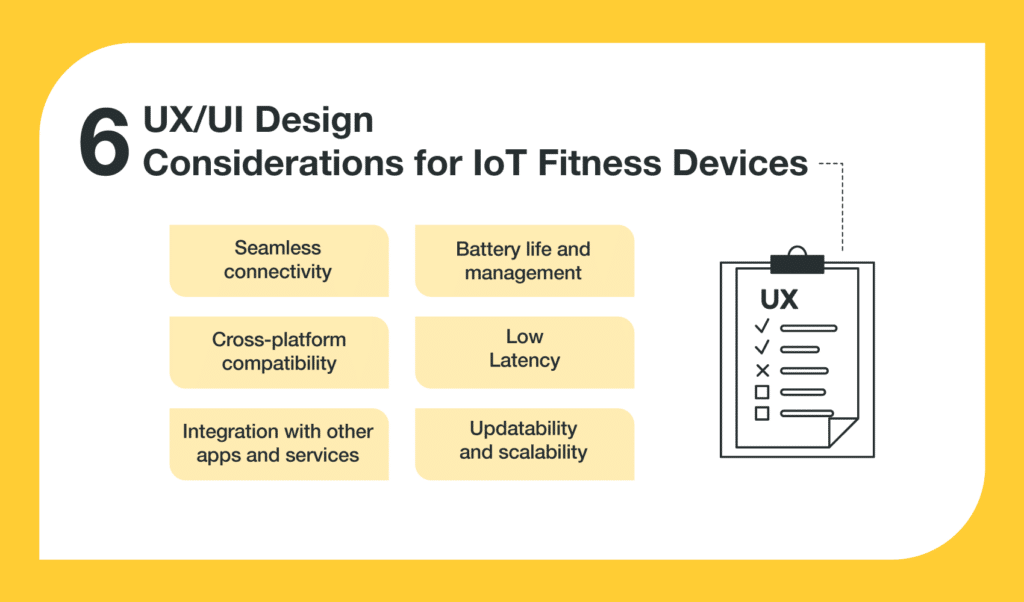BLOG
6 UX/UI Design Considerations for IoT Fitness Devices
For manufacturers of connected fitness devices, enhancing the user experience through innovative design strategies is a constant challenge. As IoT fitness devices become more prevalent in our daily health routines, the emphasis on user-centric design in both hardware and software is more critical than ever.
There are several additional UX/UI design considerations that are crucial for creating a coherent and frictionless user experience, ensuring the device not only functions optimally but also integrates smoothly into consumers’ daily lives and digital ecosystems.
Here are six key things to consider when designing your IoT fitness device:

Seamless connectivity
IoT fitness devices often need to connect to the internet, smartphones, and/or other smart devices. As a result, seamless connectivity is vital to ensure data is synced properly, and the user can access cloud-based features, and receive updates and notifications without user intervention.
Ensuring your fitness device has reliable Bluetooth, WiFi, cellular, or other pairing protocols like LoRa or LoRaWAN can enhance the user experience. It’s also imperative to provide clear on-device or app-based instructions when things go wrong, which will always happen. The experience of reconnecting is arguably even more crucial than the experience of being connected.
Cross-platform compatibility
Most consumers today own a diverse range of devices and operating systems, such as Android, iOS or Windows to name a few. Ensuring compatibility across multiple platforms allows users to access their data and device features from any device, enhancing usability and flexibility.
Make sure that you develop apps and software that are compatible with all of the major operating systems and test across different devices to ensure a consistent and reliable experience. Take into consideration the constraints and conventions of each platform in your UI design to meet the end users’ expectations on each device.
Integration with other apps and services
It’s not unusual for users to use multiple apps or services for fitness tracking, health monitoring, and social sharing. As a result, it’s important that they have the ability to integrate and share data across these platforms as it can greatly enhance the value and usability of your fitness device.
Provide APIs or support for popular health and fitness platforms, allowing users to sync their data with other apps. You’ll also want to ensure that data sharing and privacy settings are transparent and easy to manage from the end user’s perspective.
Battery life and management
Many IoT fitness devices are being used throughout the day, often to monitor specific health metrics. Optimizing battery life and providing clear information on battery status and energy-saving options will go a long way in increasing user satisfaction.
To accommodate this extended usage, make sure that your design interfaces include battery life indicators and notifications for low battery status. Offer power-saving modes that reduce device functionality or connectivity to extend battery life when needed.
Low Latency
To avoid frustration for the end user, it’s imperative to prioritize low latency in your device’s interactions. This means ensuring that the software swiftly and accurately interprets the physical actions—whether pressing buttons, using touch screens, or making gestures.
Make certain that the hardware controls on your fitness device are not only intuitively designed but also provide immediate tactile feedback that aligns seamlessly with the software actions. For instance, implementing a vibration or an instantaneous visual response on the screen immediately after a button press or gesture can greatly enhance the user experience.
Updatability and scalability
It’s true that technology is evolving quickly but so are user expectations. Consumers will be expecting you to continue to add new features, improve functionality, and fix bugs on a regular basis.
To avoid disrupting the user experience, design your system to allow for over-the-air (OTA) updates. Provide clear communication with your users when updates are available or required, and ensure the process is as seamless as possible.
A holistic approach to UX/UI design
Keeping these six considerations in mind, you can create IoT fitness devices that not only meet the immediate needs of your end users but will be better positioned to adapt to future technological advancements and changing consumer expectations. This holistic approach to UX/UI design, emphasizing both the physical and digital aspects of the device, is key to creating products that deliver lasting value and satisfaction.









